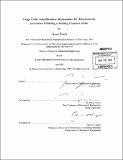Large gain amplification mechanism for piezoelectric actuators utilizing a rolling contact joint
Author(s)
Torres, James, Ph. D. Massachusetts Institute of Technology.
DownloadFull printable version (6.483Mb)
Other Contributors
Massachusetts Institute of Technology. Dept. of Mechanical Engineering.
Advisor
H. Harry Asada.
Terms of use
Metadata
Show full item recordAbstract
Due to the limited displacement of piezoelectric stack actuators, common practice is to use some form of displacement amplification mechanism. An efficient, heavy-duty displacement amplification mechanism for piezoelectric stack actuators is presented in this thesis. The displacement amplification gain is increased by a factor of more than 100 in a single stage by using a buckling mechanism combined with a novel rolling contact design. Unlike traditional flexure-type monolithic mechanisms, which are accurate but inefficient and fragile, the new mechanism consists of all rolling contact couples, providing high stiffness, durability and energy efficient characteristics. Furthermore, a new design of pre-loading mechanism using shape memory alloy doubles the possible cyclic work output and provides a desirable restoring force for constraining the rolling contact mechanism stably and efficiently. This mechanism is intended to be interfaced with a sinusoidal gear cam that acts as the load. The dynamics of the system are derived and are shown to be fifth order. Due to the significantly nonlinear amplification caused by the buckling phenomenon and the gear, the dynamics are run in simulation to gain insight into the dynamic performance of the actuator. There is shown to be an optimal speed at which to run the actuator to maximize the possible power output. Furthermore, due to the simple binary control significant benefits are achieved by varying the control timing based on the velocity to ensure the force and velocity of the output are in phase. Finally, a prototype was constructed to compare to the static model. The prototype had a peak to peak displacement of 6.8 mm, an amplification of over 150, and produced a peak charged force of 56 Newtons.
Description
Thesis (S.M.)--Massachusetts Institute of Technology, Dept. of Mechanical Engineering, 2012. Cataloged from PDF version of thesis. Includes bibliographical references (p. 55-56).
Date issued
2012Department
Massachusetts Institute of Technology. Department of Mechanical EngineeringPublisher
Massachusetts Institute of Technology
Keywords
Mechanical Engineering.